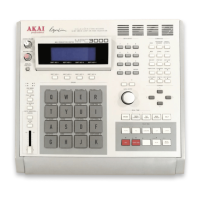Chapter 1: Introduction
Page 4
• The Best Start feature automatically finds the point within a
sound at which the drum strike begins, bypassing any dead space at
the beginning of the sound which could cause playback delays.
• Up to three sounds can be assigned to a MIDI note number or pad.
The sounds can either play simultaneously, switch depending on
note velocity, or switch depending on envelope decay (to simulate
the MPC60’s hi-hat decay slider function).
• The stereo and individual output mixers are automated. Any
changes made while recording will be automatically repeated on
playback.
Sequencer
• Both linear and pattern-style (looped) recording are supported.
• Both drum machine and sequencer-oriented features are inte-
grated into one easy-to-use operating system.
• 75,000 note sequencer capacity.
• 99 sequences may be held in memory at once. Each sequence
contains 99 individual tracks, each of which can be output to any
one or two MIDI channels.
• 4 independent MIDI output ports permit 64 simultaneous MIDI
output channels.
• 2 mergeable MIDI inputs.
• The MPC3000 may be slaved to five sync sources: MIDI Clock,
MIDI Time Code, FSK24, sync to any sound playing 1/4-notes, and
SMPTE (optional).
• 2 sequence record modes: Record (erasing existing notes while
recording) and Overdub (merge with existing notes). You can switch
between modes at any time.
• Step Edit feature allows fast viewing, recording, editing, or
deletion of any event within a sequence.
• The Simul Sequence feature allows two sequences, or one se-
quence and one song, to play simultaneously. For example, you could
play a short, looped drum sequence while simultaneously recording
your multitrack keyboard sequence.
• Versatile editing system allows erasing, time shifting, copying,
merging, inserting, and deleting of any sequence data.
• Individual parameters within note events may be changed for
multiple notes globally.
• Each track has an adjustable output level, allowing output veloci-
ties to be scaled in real time while playing.
• All 16 MIDI channels can be recorded simultaneously, allowing
sequences to be transferred to the MPC3000 from an external
sequencer in one pass.
• The Edit Loop feature allows a portion of a sequence to be looped
while overdubbing, and allows changes to be undone.
• Sequences may be transposed, either in real time while playing or
by altering note data.
• The Tap Tempo feature allows the playback tempo to be set by
tapping a key in the time of 1/4-notes.

